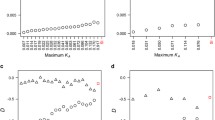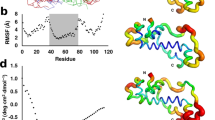Abstract
Statistical analysis of aligned DNA sequences, both among and within species, has proven to be a valuable tool for inferring the evolutionary history of genetic loci. Of particular interest are cases where the observed data depart from the neutral expectation and suggest adaptive evolution due to positive natural selection. In this chapter, we use the Drosophila janusA, janusB and ocnus genes to demonstrate methods of evolutionary inference from both inter- and intraspecific DNA sequence data. Interspecific comparisons suggest that these three paralogous, testes-expressed genes have diverged in function following duplication and have evolved under different selective constraints. The three genes show the increased rate of between-species amino acid replacement common to genes with reproductive function, which may be the result of recurrent positive selection. Intraspecific comparison of D. simulans alleles provides evidence for more recent positive selection in this region of the genome. There are two divergent haplotype groups segregating in the worldwide population, one of which has risen to high frequency within the past 5000 years. The observed pattern of within-species variation may best be explained by a selective sweep that has not gone to completion.
Access this chapter
Tax calculation will be finalised at checkout
Purchases are for personal use only
Preview
Unable to display preview. Download preview PDF.
Similar content being viewed by others
References
Kimura M. The neutral theory of molecular evolution. Cambridge: Cambridge University Press, 1983.
Endo T, Ikeo K, Gojobori T. Large-scale search for genes on which positive selection may operate. Mol Biol Evol 1996; 13:685–690.
Fitch WM, Bush RM, Bender CA et al. Long term trends in the evolution of H(3) HA1 human influenza type A. Proc Natl Acad Sci USA 1997; 94:7712–7718.
Yang Z, Nielsen R, Goldman N et al. Codon-substitution models for heterogeneous selection pressure at amino acid sites. Genetics 2000; 155:431–449.
Tsaur SC, Wu CI. Positive selection and the molecular evolution of a gene of male reproduction, Acp26Aa of Drosophila. Mol Biol Evol 1997; 14:544–549.
Wyckoff GJ, Wang W, Wu CI. Rapid evolution of male reproductive genes in the descent of man. Nature 2000; 403:304–309.
Swanson WJ, Clark AG, Waldrip-Dail HM et al. Evolutionary EST analysis identifies rapidly evolving male reproductive proteins in Drosophila. Proc Natl Acad Sci USA 2001; 98:7375–7379.
Yang Z, Swanson WJ. Codon-substitution models to detect adaptive evolution that account for heterogeneous selective pressures among site classes. Mol Biol Evol 2002; 19:49–57.
Maynard Smith J, Haigh J. The hitch-hiking effect of a favourable gene. Genet Res 1974; 23:23–35.
Kaplan NL, Hudson RR, Langley CH. The “hitchhiking effect” revisited. Genetics 1989; 123:887–899.
Stephan W, Wiehe THE, Lenz MW. The effect of strongly selected substitutions on neutral polymorphism: Analytical results based on diffusion theory. Theor Pop Biol 1992; 41:237–254.
Aguadé M, Miyashita N, Langley CH. Restriction-map variation at the zeste-tko region in natural populations of Drosophila melanogaster. Mol Biol Evol 1989; 6:123–130.
Stephan W, Langley CH. Molecular genetic variation in the centromeric region of the X chromosome in three Drosophila ananassae populations. I. contrasts between the vermilion and forked loci. Genetics 1989; 121:89–99.
Begun DJ, Aquadro CF. Molecular population genetics of the distal portion of the X chromosome in Drosophila: Evidence for genetic hitchhiking of the yellow-achaete region. Genetics 1991; 129:1147–1158.
Berry AJ, Ajioka JW, Kreitman M. Lack of polymorphism on the Drosophila fourth chromosome resulting from selection. Genetics 1991; 129:1111–1117.
Charlesworth B, Morgan MT, Charlesworth D. The effect of deleterious mutations on neutral molecular variation. Genetics 1993; 134:1289–1303.
Tajima F. Statistical method for testing the neutral mutation hypothesis by DNA polymorphism. Genetics 1989; 123:585–595.
Hudson RR, Bailey K, Skarecky D et al. Evidence for positive selection in the superoxide dismutase (Sod) region of Drosophila melanogaster. Genetics 1994; 136:1329–1340.
Depaulis F, Veuille M. Neutrality tests based on the distribution of haplotypes under an infinite-site model. Mol Biol Evol 1998; 15:1788–1790.
Fu YX, Li WH. Statistical tests of neutrality of mutations. Genetics 1993; 133:693–709.
Fay JC, Wu CI. Hitchhiking under positive Darwinian selection. Genetics 2000; 155:1405–1413.
Kim Y, Stephan W. Detecting a local signature of genetic hitchhiking along a recombining chromosome. Genetics 2002; 160:765–777.
Begun DJ, Aquadro CF. Levels of naturally occurring DNA polymorphism correlate with recombination rates in D. melanogaster. Nature 1992; 356:519–520.
Hudson RR, Kreitman M, Aguadé M. A test of neutral molecular evolution based on nucleotide data. Genetics 1987; 116:153–159.
McDonald JH, Kreitman M. Adaptive protein evolution at the Adh locus in Drosophila. Nature 1991; 351:652–654.
Yanicostas C, Vincent A, Lepesant JA. Transcriptional and posttranscriptional regulation contributes to the sex-regulated expression of two sequence-related genes at the janus locus of Drosophila melanogaster. Mol Cell Biol 1989; 9:2526–2535.
Yanicostas C, Lepesant JA. Transcriptional and translational cis-regulatory sequences of the spermatocyte-specific Drosophila janusB gene are located in the 3′ exonic region of the overlapping janusA gene. Mol Gen Genet 1990; 224:450–458.
Parsch J, Meiklejohn CD, Hauschteck-Jungen E et al. Molecular evolution of the ocnus and janus genes in the Drosophila melanogaster species subgroup. Mol Biol Evol 2001; 18:801–811.
Yanicostas C, Ferrer P, Vincent A et al. Separate cis-regulatory sequences control expression of serendipity β and janus A, two immediately adjacent Drosophila genes. Mol Gen Genet 1995; 246:549–560.
C. elegans sequencing consortium. Genome sequence of the nematode C. elegans: A platform for investigating biology. Science 1998; 282:2012–2018.
Civetta A, Singh RS. Sex-related genes, directional sexual selection, and speciation. Mol Biol Evol 1998; 15:901–909.
Parsch J, Meiklejohn CD, Hartl DL. Patterns of DNA sequence variation suggest the recent action of positive selection in the janus-ocnus region of Drosophila simulans. Genetics 2001; 159:647–657.
Moriyama EN, Powell JR. Intraspecific nuclear DNA variation in Drosophila. Mol Biol Evol 1996; 13:261–277.
Rozas J, Gullaud M, Blandin G et al. DNA variation at the rp49 gene region of Drosophila simulans: Evolutionary inferences from an unusual haplotype structure. Genetics 2001; 158:1147–1155.
Begun DJ, Whitley P. Reduced X-linked nucleotide polymorphism in Drosophila simulans. Proc Nacl Acad Sci USA 2000; 97:5960–5965.
Hamblin MT, Aquadro CF. High nucleotide sequence variation in a region of low recombination in Drosophila simulans is consistent with the background selection model. Mol Biol Evol 1996; 13:1133–1140.
True JR., Mercer JM, Laurie CC. Differences in crossover frequency and distribution among three sibling species of Drosophila. Genetics 1996; 142:507–523.
Kim Y, Stephan W. Joint effects of genetic hitchhiking and background selection on neutral variation. Genetics 2000; 155:1415–1427.
Kirby DA, Stephan W. Multi-locus selection and the structure of variation at the white gene of Drosophila melanogaster. Genetics 1996; 144:635–645.
Adams MD, Celniker SE, Holt RA et al. The genome sequence of Drosophila melanogaster. Science 2000; 287:2185–2195.
Author information
Authors and Affiliations
Editor information
Editors and Affiliations
Rights and permissions
Copyright information
© 2005 Eurekah.com and Kluwer Academic/Plenum Publishers
About this chapter
Cite this chapter
Parsch, J., Meiklejohn, C.D., Hartl, D.L. (2005). Inferring Evolutionary History through Inter- and Intraspecific DNA Sequence Comparison. In: Nurminsky, D. (eds) Selective Sweep. Molecular Biology Intelligence Unit. Springer, Boston, MA. https://doi.org/10.1007/0-387-27651-3_1
Download citation
DOI: https://doi.org/10.1007/0-387-27651-3_1
Publisher Name: Springer, Boston, MA
Print ISBN: 978-0-306-48235-9
Online ISBN: 978-0-387-27651-9
eBook Packages: Biomedical and Life SciencesBiomedical and Life Sciences (R0)




